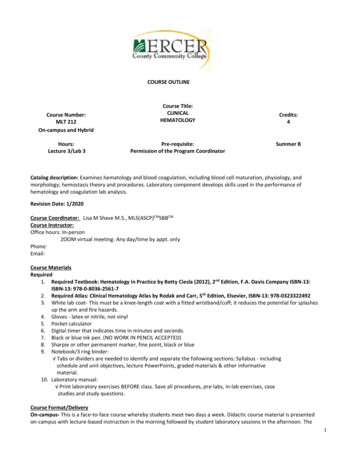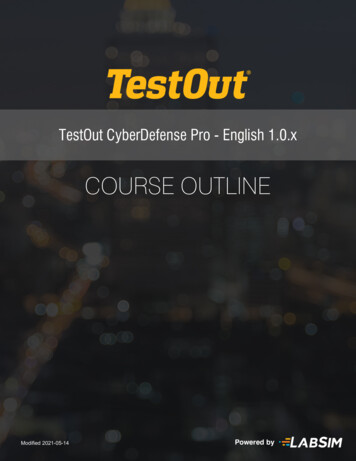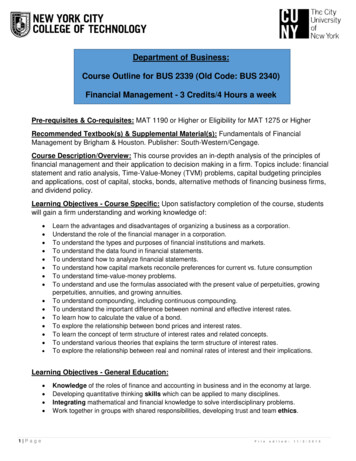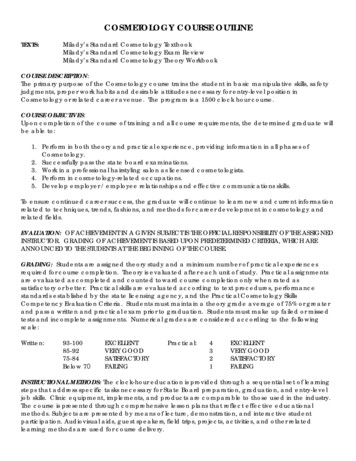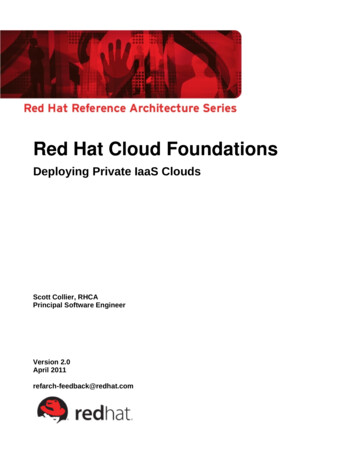![Academy Cloud Foundations Course Outline [English]](/img/13/academy-20cloud-20foundations-20course-20outline-20-english.jpg)
Transcription
Course OutlineAWS Academy Cloud Foundations (ACF)Course VersionThis course outline applies to version 1.0 of AWS Academy Cloud Formations in English.DescriptionAWS Academy Cloud Foundations is intended for students who seek an overall understanding of cloudcomputing concepts, independent of specific technical roles. It provides a detailed overview of cloudconcepts, AWS core services, security, architecture, pricing, and support.Course ObjectivesUpon completion of this course, students will be able to: 1Describe the six advantages of cloud computingDescribe three cloud deployment modelsUse the AWS Cloud Adoption Framework to help organizations transform the way they workUnderstand the AWS pricing philosophyReview fundamental pricing characteristicsUnderstand the elements of Total Cost of OwnershipUnderstand the difference between AWS Regions, Availability Zones, and Edge LocationsUnderstand the different AWS compute servicesDescribe Amazon Elastic Compute CloudExplain AWS Lambda, which is serverless computingDescribe AWS Elastic BeanstalkDiscuss storage services including Amazon EBS, Amazon S3, Amazon EFS, and Amazon GlacierDescribe use cases for storage options, along with a demonstration of Amazon GlacierUnderstand storage pricingUnderstand virtual networking in the cloud with Amazon VPCCreate virtual firewalls with security groupsSecure delivery of data, videos, applications, and APIs with Amazon CloudFrontProvide an overview of different database services in the cloudHighlight the differences between unmanaged and managed database solutionsDifferentiate between Structured Query Language and NoSQL databasesReview the availability differences of alternative database solutionsLearn how to distribute traffic across Amazon EC2 instances using Elastic Load BalancingDiscover the ability of Auto Scaling to launch servers in response to workload changesUse CloudWatch to monitor AWS resources and applications in real timeDescribe the AWS Shared Responsibility ModelExamine IAM users, groups, and rolesDescribe different types of security credentialsReview the AWS Trusted Advisor checksDiscuss security complianceUnderstand best practices on day 1 with a new AWS accountExplore the well-architected pillars and design principlesUnderstand high availability and 05-28
Course OutlineAWS Academy Cloud Foundations (ACF) Describe the business impact of design decisionsDescribe how to set up an organizational structure to simplify billing and account visibilityIdentify alternative support options and featuresDurationApproximately 20-30 hours. When delivered synchronously by an educator, total duration is 28.5hours. Digital training modules total seven hours in duration. Actual delivery times will vary from classto class and depending on the delivery format. AWS Academy Cloud Foundations must be deliveredover a period of at least two weeks.Intended AudienceThis introductory (level 100) course is intended for AWS Academy member institutions.Student PrerequisitesThis is an entry-level course, but students should possess: General IT technical knowledgeGeneral IT business knowledgeDelivery MethodsThis course can be delivered in person with synchronous lectures or with digital training models thatstudents can complete independently.Educator PrerequisitesEducators must hold a current AWS Certified Cloud Practitioner certification to teach this course.Educator AccreditationEducators meeting the prerequisites have no further accreditation requirements.Learning Resources 2Lecture materialsOnline multiple-choice knowledge checksLab exercisesDigital training (optional)Video introductionsVideo demosExample -28
Course OutlineAWS Academy Cloud Foundations (ACF)Course ContentsDigital training materials cover the same content as the lectures. It is not necessary to use both.SlidesCourse IntroductionVideoIntroduction to AWS Academy CloudFoundationsDigital TrainingWelcome to AWS Academy CloudFoundationsLectureCourse Overview and ObjectivesLectureCreating your AWS Training Portal AccountLectureAccess Your Course MaterialsModule 1 – Cloud ConceptsSection 1: Cloud Concepts OverviewVideoIntroduction to Cloud ComputingLectureWhat is Cloud Computing?Digital TrainingWhat is Cloud Computing?LectureSix Advantages of Cloud ComputingLectureWhat is Amazon Web Services (AWS)LectureThe AWS Cloud Adoption Framework (CAF)Knowledge CheckCloud ConceptsSection 2: Cloud EconomicsLectureFundamentals of PricingLectureTotal Cost of OwnershipDigital TrainingIntroduction to Cloud EconomicsKnowledge CheckCloud EconomicsSection 3: AWS Global Infrastructure OverviewVideoIntroduction to the AWS InfrastructureLectureAWS Global InfrastructureDigital TrainingIntroduction to the AWS InfrastructureLectureAWS Service and Service Category OverviewKnowledge CheckAWS Global InfrastructureModule 2 – AWS Core ServicesVideoIntroduction to Core ServicesSection 1: ComputeVideoIntroduction to ComputeLectureCompute Services OverviewLectureIntroduction to Amazon Elastic ComputeCloud (EC2)Digital TrainingIntroduction to ComputeVideoAmazon EC2 Console DemoLabIntroduction to Amazon EC2LectureAmazon EC2 Cost OptimizationLectureIntroduction to AWS LambdaLectureIntroduction to AWS Elastic BeanstalkKnowledge CheckCompute ServicesSection 2: StorageVideoIntroduction to 2848DigitalTraining18 min.LabKnowledgeCheck4632 min.10 min.3332 min.10 min.1813 min.10 min.6745 min.10 min.5540 min.10 min.
Course OutlineAWS Academy Cloud Foundations (ACF)Digital tureVideoKnowledge CheckSection 3: VPCVideoLectureLectureVideoLabLectureKnowledge CheckSection 4: ntroduction to StorageAmazon Elastic Block Store (EBS)Amazon EBS DemoWorking with EBSAmazon Simple Storage Service (S3)Amazon S3 DemoAmazon Elastic File System (EFS)Amazon EFS DemoAmazon GlacierAmazon Glacier DemoStorage ServicesAmazon Relational Database Service (RDS)Amazon RDS DemoAmazon DynamoDBAmazon DynamoDB DemoAmazon RedshiftAmazon AuroraBuild Your DB Server and Interact with YourDB Using an AppKnowledge CheckDatabases ServicesSection 5: Balancing, Scaling, MonitoringLectureElastic Load Balancing (ELB)LectureAmazon CloudWatchLectureAuto ScalingDigital TrainingBalancing, Scaling, and MonitoringLabScale and Load Balance Your ArchitectureKnowledge CheckBalancing, Scaling, and MonitoringModule 3 – Cloud SecurityVideoIntroduction to Cloud SecurityLectureAWS Shared Responsibility ModelLectureAWS Identity and Access Management (IAM)VideoIAM DemoLectureAWS Trusted AdvisorLectureAWS CloudTrailLectureAWS ConfigLectureAWS Day One Best Practice ReviewLectureAWS Security and Compliance ProgramsLectureAWS Security ResourcesDigital TrainingAWS Cloud SecurityLabIntroduction to AWS IAM43725 min.45 min.10 min.5436 min.45 min.10 min.3925 min.45 min.10 min.9170 min.30 min.10 min.Introduction to the Amazon Virtual PrivateCloud (VPC)Amazon Virtual Private Cloud (VPC)Amazon VPC Security GroupsAmazon VPC DemoBuild your VPC and Launch a Web ServerAmazon CloudFrontAmazon Virtual Private Cloudaws.amazon.com/training/awsacademy2019-05-28
Course OutlineAWS Academy Cloud Foundations (ACF)DemonstrationIAM Demonstration (optional)Knowledge CheckCloud SecurityModule 4 – Cloud ArchitectingVideoIntroduction to Cloud ArchitectingLectureIntroduction to the Well-ArchitectedFrameworkLectureWell-Architected Design PrinciplesLectureUnderstanding Reliability and HighAvailabilityExampleTransitioning a Data Center to the CloudDigital TrainingIntroduction to Cloud ArchitectingKnowledge CheckCloud ArchitectingModule 5 – Cloud SupportLectureIntroduction to AWS OrganizationsLectureAWS Cost ExplorerLectureOverview of AWS Technical Support Plansand CostsDigital TrainingCloud Billing and SupportKnowledge CheckCloud Billing and SupportRecommended and emy2019-05-284937 min.10 min.3322 min.10 min.
Course OutlineAWS Academy Cloud Foundations (ACF)Appendix - Module ObjectivesModule 0 - Welcome to AWS Academy (48 slides, 18 min.)In this module, we are going to provide a course overview and review the course objectives. We willwalk through the creation of your AWS training portal account and show you how to access the coursematerials. Two optional sections have been included that illustrate how to create your AWS Free Tierand AWS Educate accounts.Upon completing this module, students will be able to: Review course objectives and a course overview of what is contained in the Academy CloudFoundations curriculum.Create AWS accounts that will enhance your cloud-learning journey.Module 1.1 - Cloud Concepts OverviewIn this module, we will discuss the basics of cloud computing. You will learn what cloud computing isand discover the six advantages of cloud computing. We will reveal what Amazon Web Services is, aswell as the AWS Cloud Adoption Framework. This course assumes you have a non-IT background, as itwill not teach you how to build applications in the cloud. This course will give you a general conceptualunderstanding about the cloud and AWS.Upon completing this module, students will be able to: Define different types of cloud computing to understand internet-based computing and threecategories of cloud computing. Describe the six advantages of cloud computing, helping organizations make the decision toget out of the low-value parts of IT and focus on what drives business success. Describe three cloud deployment models for alternative models of cloud usage. Review the AWS Cloud Adoption Framework which helps organizations understand how cloudadoption transforms the way they work.Module 1.2 - Cloud EconomicsThis module reviews the economics of cloud computing. You will be introduced to the fundamentals ofpricing, and we will review the total cost of ownership.Upon completing this module, students will be able to: Understand the AWS pricing philosophy. Review fundamental pricing characteristics. Understand the elements of Total Cost of 05-28
Course OutlineAWS Academy Cloud Foundations (ACF)Module 1.3 - AWS Infrastructure OverviewThe goal of this module is to understand the AWS global infrastructure and the types of services thatare available. We will examine the AWS Global Infrastructure to gain a clear understanding of what theinfrastructure includes, and understand the differences between AWS Regions, Availability Zones, andEdge Locations.Upon completing this module, students will be able to: Examine the AWS global infrastructure Understand the difference between AWS Regions, Availability Zones, and Edge LocationsModule 2.1 - AWS Core Services: ComputeAmazon Web Services provides multiple services to build out a solution. Some of these services providethe foundation to all solutions. We refer to these as the core services. In this module, we provideinsight into the offerings of each service category and look at our first group of services, compute.Upon completing this module, students will be able to: Understand the different AWS compute services available in the cloud to power your solution Discover an in-depth review of Amazon Elastic Compute Cloud Explain AWS Lambda, which is serverless computing Review AWS Elastic BeanstalkModule 2.2 - AWS Core Services: StorageCloud storage is typically more reliable, scalable, and secure than traditional on-premises storagesystems. Cloud storage is a critical component of cloud computing, holding the information used byapplications. Big data analytics, data warehouses, Internet of Things databases, and backup and archiveapplications all rely on some form of data storage architecture. In this module, we will explore AmazonElastic Block Store, Amazon Simple Storage Service, Amazon Elastic File System, and Amazon GlacierUpon completing this module, students will be able to: Discuss storage services including Amazon EBS, Amazon S3, Amazon EFS, and Amazon Glacier Review use cases for storage options, along with a demonstration of Amazon Glacier Understand storage pricingModule 2.3 - AWS Core Services – Amazon Virtual Private CloudThe Amazon Virtual Private Cloud is a custom-defined network within the AWS Cloud. It enables you todesign and implement an independent network that operates in the cloud. We will understand thefeatures and benefits of Amazon VPC, review Amazon VPC Security Groups and learn about AmazonCloudFront, a global Content Delivery Network service that securely delivers data, videos, applications,and APIs to your viewers with low latency and high transfer speeds.Upon completing this module, students will be able to: Understand virtual networking in the cloud with Amazon VPC Create virtual firewalls with security groups Secure delivery of data, videos, applications, and APIs with Amazon 05-28
Course OutlineAWS Academy Cloud Foundations (ACF)Module 2.4 - AWS Core Services: DatabasesThe business world is constantly changing and evolving. By accurately and efficiently recording,updating, and tracking data on regular basis, companies can leverage the immense potential of theinsights obtained from their data. Database management systems are crucial for managing this data.Like other cloud services, cloud databases offer significant cost advantages over traditional databasestrategies. We will review the Amazon Relational Database Service, Amazon DynamoDB, AmazonRedshift, and Amazon Aurora. You will complete a lab to build your DB server and interact with yourdatabase using the app.Upon completing this module, students will be able to: Provide an overview of different database services in the cloud Highlight the difference between unmanaged and managed database solutions Understand the differences between Structured Query Language and NoSQL databases Review the availability differences of alternative database solutionsModule 2.5 - AWS Core Services: Elastic Load Balancing, Amazon CloudWatch, and Auto ScalingAWS Core Services includes Elastic Load Balancing, Amazon CloudWatch, and Auto Scaling. In thismodule, you will learn how each of these services work both independently and together to help youdeploy highly available and optimized workloads on AWS. You will complete a lab to scale and loadbalance your architecture.Upon completing this module, students will be able to: Learn how to distribute traffic across Amazon Elastic Compute Cloud instances using ElasticLoad Balancing Discover the ability of Auto Scaling to launch and release servers in response to workloadchanges Realize how CloudWatch enables you to monitor AWS resources and applications in real timeModule 3 - AWS Cloud SecurityThis module will familiarize you with all of the security considerations for your cloud solution. We willreview security tools and best practices to help you understand key security concepts related to theShared Responsibility Model and IAM.Upon completing this module, students will be able to: Describe the AWS Shared Responsibility Model Examine IAM users, groups, and roles Describe different types of security credentials Review the AWS Trusted Advisor checks Discuss security compliance Understand best practices on day 1 with a new AWS 28
Course OutlineAWS Academy Cloud Foundations (ACF)Module 4 - Cloud ArchitectingThe goal of this module is to introduce you to some foundational cloud architecting concepts.Architecture is the art and science of designing and building large structures. We will review andunderstand the well-architected framework and associated design. This knowledge will help you beginto understand how to create a well-architected cloud solution.Upon completing this module, students will be able to: Explore the well-architected pillars and design principles Understand high availability and reliability Understand the business impact of design decisionsModule 5 - Cloud Billing and SupportThis module was designed to provide an overview of AWS billing and support services. We will reviewAWS Organizations, which helps you manage multiple AWS accounts and consolidated billing. We willalso look at tools that enable you to view and estimate costs. Finally, we will close with a look at howto find AWS whitepapers and documentation on all AWS services, features, and resources.Upon completing this module, students will be able to: Understand how to set up an organizational structure that simplifies billing and accountvisibility to review cost data Identify alternative support options and -28
Module 4 – Cloud Architecting 49 37 min. 10 min. Video Introduction to Cloud Architecting Lecture Introduction to the Well-Architected Framework Lecture Well-Architected Design Principles Lecture Understanding Reliability and High Availability Example

